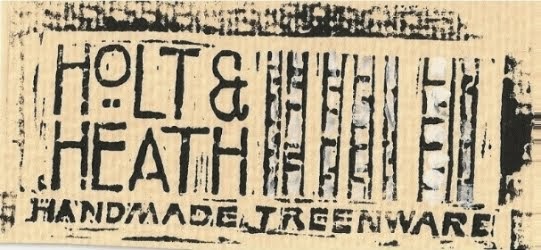Well, it's not exactly a chair, and I'm not particularly proud of it, but I guess it marks the first stop on our journey to chair making. Ju and I have been on school holiday this past week and we had lofty intentions of starting our chair project, but what we hadn't banked on was young children with chicken pox, tonsillitis and a bad back which meant I could hardly stand up. Well, we got together at Ju's on the Monday and I took with me some stool parts that I had begun some time ago and probably should have thrown away but I am more stubborn (and stupid) than that. I read a recent post on Peter Follansbee's blog asking the question 'what is green wood working' - well I'll tell you this for nothing, this oak was far from green wood. I'd been given the wood some time ago by my friend Dave - I'd guess 2 years ago. The legs I had hewn and shaved into rough octagons when they were green - the seat, which is a slab of oak (as are the legs) I have had drying out and seasoning nicely in my shed for the past couple of years. I must say, this is not a technique I would recommend, trying to carve seasoned oak, but needs must, and all that.

I saddled the seat using a couple wood gouges, a larger on first then went over it all again with a finer one to give more defined cuts. I had already decided to leave it with tool marks on as I really like the effect, not only because as yet neither of us have an inshave or travisher - I'm going to have to save up for one as they are not cheap. I had made things more difficult by leaving the rounded shape of the original oak log on the underside of the seat, meaning that clamping it down for carving was more difficult than it need have been as it rocked around all over the place. Still, a good lesson.
Once the seat was finished we drilled mortices with a brace and bit, estimating the angles as best we could using a carpenters adjustable square, and was quite happy with what we achieved. Drilling from the underside did mean we got some tear-out when the drill bit broke through the surface on the seat side - we'll have to work-out how to overcome that - any suggestions appreciated.
Julian had invested in a 5/8" Veritas tenon cutter which is a formidable bit of kit. For those who haven't seen one before, they look like this:
Ostensibly a great big pencil sharpener affair that you fix to your power drill and then offer up the legs or rungs or spindles you want a tenon on and Bob's your uncle - easier than falling off a horse (Aside - Dave, I know you were wary of using your lovely tenon cutter with seasoned oak but it cut through it like a hot knife through butter!).
EXCEPT: once you introduce the end of your leg into the funnel of the tenon cutter and the blade engages the wood, it snatches it up, draws it in and, if you're not careful, before you know it you've cut it and if it's wrong then it's too bad. There are methods of ensuring you don't cut the tenon any longer than you want it, but the mistake we made was getting carried away cutting the tenons without first checking how to ensure that the leg was centred, so that the tenon is in the centre, or that we were cutting straight and not off at an angle. Again, any advice on how to achieve this would be much appreciated. As it happens, our tenons turned out, shall we say, less than perfect, meaning that all the effort we had put into boring the angles of the mortises was a waste of time since the irregular tenons meant they were all skewiff anyway (that's colloquial English for wonky).

Anyway, we fitted the legs with a smear of PVA, since the parts were all dry so there was not going to be any shrink tightening. I had cut slots in the leg tenons, going with the grain, then knocked in wedges of dry ash, again making sure they were aligned against the grain so as not to open a split in the seat. We followed Drew Langsner's technique for leveling the legs - something we got wrong the first time and had to do again as we had one leg shorter than all the rest (invaluable lesson - once the angles have been marked on the bottom of each leg, turn the stool so that the face of the leg you are trimming to length is facing up, otherwise there's a risk of cutting the front of the leg too short; this is difficult to explain, but trust me, it makes a difference, or it did to us the first time we cut the legs) - which was a really clever but simple technique employing a pair of compasses and a bunch of small wedges cut from waste.

So, here is the finished stool - and it only took me best part of four years talking and thinking about it.
 |
| Look carefully and you can see the tear-out beside the revealed leg tenons. |
 |
| Strong enough to hold me and Saxon for a bedtime story. |
 |
| Saxon took an immediate shine to it so I thought it best if he had it. And doesn't he look thrilled - so easily pleased at that age. |
...and good enough for Ninja Turtles!
As you can see, the angle on the spread of the front legs is not equal - not because the mortices were mis-cut but because the tenons were off centre and strangely angled - as I said 'skewiff'.





































